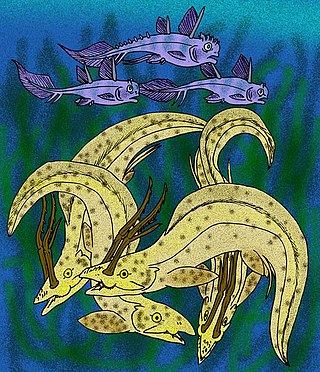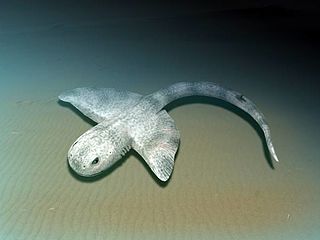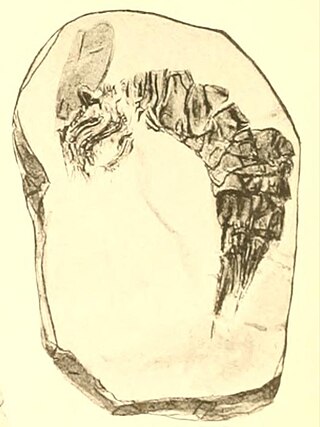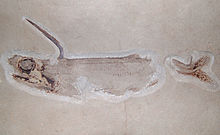
Stethacanthus is an extinct genus of shark-like holocephalians which lived from the Late Devonian to Late Carboniferous epoch, dying out around 298.9 million years ago. Fossils have been found in Australia, Asia, Europe and North America.

The Bear Gulch Limestone is a limestone-rich geological lens in central Montana, renowned for the quality of its late Mississippian-aged fossils. It is exposed over a number of outcrops northeast of the Big Snowy Mountains, and is often considered a component of the more widespread Heath Formation. The Bear Gulch Limestone reconstructs a diverse, though isolated, marine ecosystem which developed near the end of the Serpukhovian age. It is a lagerstätte, a particular type of rock unit with exceptional fossil preservation of both articulated skeletons and soft tissues. Bear Gulch fossils include a variety of fish, invertebrates, and algae occupying a number of different habitats within a preserved shallow bay.

Belantsea is a genus of extinct petalodontid cartilaginous fish that lived during the Lower Carboniferous, about 350 million years ago. Its fossils are found in the Bear Gulch Limestone lagerstätte. Its body was leaf-shaped, with muscular fins and a small tail. Such a body plan would allow for great maneuverability, but at the cost of speedy cruising. Its few, large, triangular teeth formed a beak-like arrangement that allowed it to graze bryozoans, sponges, crinoids, and other encrusting animals. The genus contains two species, B. montana and B. occidentalis.

Symmoriiformes is an extinct order of stem-group holocephalians. Originally named Symmoriida by Zangerl (1981), it has subsequently been known by several other names. Lund (1986) synonymized the group with Cladodontida, while Maisey (2008) corrected the name to Symmoriiformes in order to prevent it from being mistaken for a family. The symmoriiform fossils record begins during the late Devonian. Most of them died out at the start of the Permian, but Dwykaselachus is known from the Artinskian-Kungurian of South Africa. Teeth described from the Valanginian of France and Austria indicate that members of the family Falcatidae might have survived until the Early Cretaceous; however, these teeth were also argued to be more likely neoselachian teeth.

Stethacanthidae is an extinct family of prehistoric holocephalians. It is estimated to have existed approximately between 380 and 300 million years ago. Members of this family are noted for their peculiar dorsal fin.

Harpagofututor is an extinct genus of cartilaginous fish from the Mississippian of North America.

Allenypterus is an extinct genus of a prehistoric lobe-finned fish which lived during the Bashkirian age of the Late Carboniferous period, 318 million years ago). Fossils have been discovered in Bear Gulch Limestone, Montana, USA.
Netsepoye is an extinct genus of cartilaginous fish distantly related to the modern order Chimaeriformes, containing the single species Netspoye hawesi. It lived more than 320 million years ago during the Late Mississippian.
Siksika ottae is an extinct species of petalodont, which lived during the Upper Mississippian. It has been discovered at the well known Carboniferous-aged Bear Gulch Limestone. It is known primarily from fossil teeth, but also from partial neurocranium and mandibles which hint at a close relationship to coeval petalodontiforms such as Janassa and Netsepoye. Dentition is generally heterodont. Siksika translates to Blackfoot, being named after the Siksika Nation.

Falcatidae is a family of Paleozoic holocephalians. Members of this family include Falcatus, a small fish from the Bear Gulch Limestone of Montana. The family first appeared around the start of the Carboniferous, and there is some evidence that they survived well into the early Cretaceous, though its putative Cretaceous members were also argued to be more likely neoselachians.

Echinochimaera is an extinct genus of chimaeriform fish, known from the Lower Carboniferous Bear Gulch Limestone in Montana, United States. It is one of the earliest Chimaeriformes known.
Lochmocercus is an extinct genus of prehistoric coelacanth fishes which lived during the Carboniferous Period.

Debeerius is a genus of chondrichthyan from the Mississippian age Bear Gulch Limestone of Montana, United States. It is named after Gavin de Beer. One species, D. ellefseni, is known.

Guildayichthyidae is a prehistoric family of marine fish from the Mississippian Bear Gulch Limestone of Montana. It is the only family in the order Guildayichthyiformes. Guildayichthyids possess an uncommon mixture of primitive and modern characteristics in their skull bones.

Thrinacodus is an extinct genus of basal elasmobranch, found worldwide from the Late Devonian-Lower Carboniferous. The type species is Thrinacodus nanus. Most species are only known from their tricuspid teeth. T. gracia, originally placed in the separate genus Thrinacoselache from the Serpukhovian-aged Bear Gulch Limestone, of what is now Montana, is known from full body impressions, showing a long, slender eel-like body up to a metre in length, with an elongate rostrum. Stomach contents of T. gracia include remains of crustaceans and small chondrichthyan fish. It is a member of the Phoebodontiformes.
Hardistiella montanensis is a fossil fish and extinct species of lamprey found, dating from the Carboniferous period, at the Bear Gulch Limestone site in the U.S. state of Montana.
Bealbonn is an extinct genus of holocephalian from the Carboniferous. It is known by a singular species, B. rogaire. It is known from the Serpukhovian-aged lagerstätte of the Bear Gulch Limestone of Montana, United States. It is one of the genera included in the family Gregoriidae.

Gregoriidae is an extinct family of early chondrichthyans from the Carboniferous period. It currently includes three described genera: Gregorius, Srianta, and Bealbonn. This family includes remains formerly ascribed to "Desmiodus," which is now considered a nomen vanum. The relationships between the included genera are not entirely clear. Fossils are known from Serpukhovian-aged formations including the Bear Gulch Limestone and Surprise Canyon Formation.

Squatinactis is a genus of extinct elasmobranch chondrichthyan known from the Carboniferous aged Bear Gulch Limestone in Montana. This fish was discovered in 1974 by Richard Lund. The type specimen, named CMNH 46133, consists of a brain case, poorly preserved jaws and gills, a pectoral fin, and a partial vertebral axis. This creatures most startling feature were its broad pectoral fins which resembled those of stingrays and angel sharks (Squatina). The holotype specimen has about 15 teeth in its jaw. This creature is named after the angel shark. Remains found in the South Urals of Russia and the Eyam Limestone of Derbyshire, England, have been tentatively identified as those belonging to S. caudispinatus.

Bairdops is an extinct genus of mantis shrimp that lived during the Early Carboniferous period in what is now Scotland and the United States. Two named species are currently assigned to it. The type species, B. elegans, has been collected from several Dinantian-aged localities in Scotland, and was first described in 1908 by British geologist Ben Peach as a species of Perimecturus. The generic name was coined decades later in 1979 by American paleontologist Frederick Schram, and honors William Baird. A later species, B. beargulchensis, was named in 1978 after the Serpukhovian-aged Bear Gulch Limestone of Montana where it was discovered. The two species were originally deemed close relatives based on their physical similarities, but several cladistic analyses published since 1998 have suggested the genus may be polyphyletic.


















